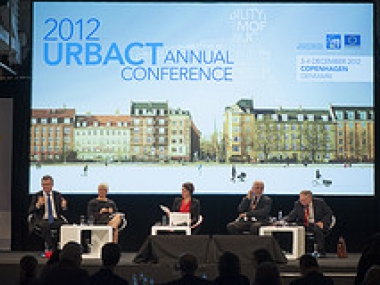Annual Conference Output - EU responses to urban challenges
Edited on
10 February 2015Is the European Union responding to urban challenges? How to deliver the Europe 2020 objectives? The panel discussion that opened the second day of the URBACT conference in Copenhagen on 4 December 2012 examined how the EU is responding to urban challenges. The panel, chaired by Darinka Czischke, comprised representatives of a city, a Member State, the European Parliament and the Commission, ensuring a multifaceted view. Discover the outputs of this panel!

The panel discussed a successful city strategy, the progress of the cohesion policy negotiations for 2014-20, and how to make the policy work for cities.
Växjö's example
Anna Tenje, Deputy Mayor of Växjö and member of the panel, told us how her city earned its reputation as Europe's greenest city.
The European Commission's proposal
Michael Ralph, Adviser to the Deputy Director General of DG Regional and Urban, presented a condensed overview of the Commission’s cohesion policy proposals. The principles are to put a stronger focus on social inclusion, to align the objectives with Europe 2020, to include an urban dimension and to base implementation on partnership and multilevel governance.
The Commission also proposes to finance innovative actions directly. URBACT will continue, but in addition an Urban Development Platform would be set up to support ITIs and innovative actions.
Balanced sustainable development
This led to the issue of whether urban policy hits the right balance between the social, economic and environmental dimensions. Iván Tosics, URBACT thematic Pole Manager, noted that energy and economic issues are taking the lead in thematic concentration, posing the risk that social issues might be ignored at European level. Claes Nilas stressed the importance of the social dimension of urban policy.
Governance tools
The following question was raised : but does the EU have the governance tools it needs to respond to urban challenges? Paolo Gandolfi, deputy mayor of Reggio Emilia, felt that an EU that is largely made up of cities would benefit from the existence of a direct link between city authorities and the European institutions. Claes Nilas said that municipalities and states must work together on all issues, from energy to segregation.
Jan Olbrycht added that urban issues cross over into many policy areas – for instance transport. But we are also facing new challenges such as climate change, dealing with the consequences of bad planning, the fact that EU funds may be used in ways that lead to urban sprawl, the need to make life cheaper for citizens affected by the crisis.
Making cohesion policy work for cities
The panel concluded with some advice on how to make the EU's cohesion policy work in cities' interests. According to the panel, the way to deliver the Europe 2020 objectives is through integrated urban policies. Urban stakeholders should gear up to ensure that Member States include them in drawing up their partnership contracts and operational programmes.
Read more:
 Download Cities of Tomorrow URBACT Annual Conference EU responses to urban challenges (530.02 KB) - Full Article by Toby Johnson - PDF
Download Cities of Tomorrow URBACT Annual Conference EU responses to urban challenges (530.02 KB) - Full Article by Toby Johnson - PDF- URBACT 2013 Annual Conference - website
- Annual Conference Output - Report on the URBACT Café - URBACT website
Submitted by admin on
